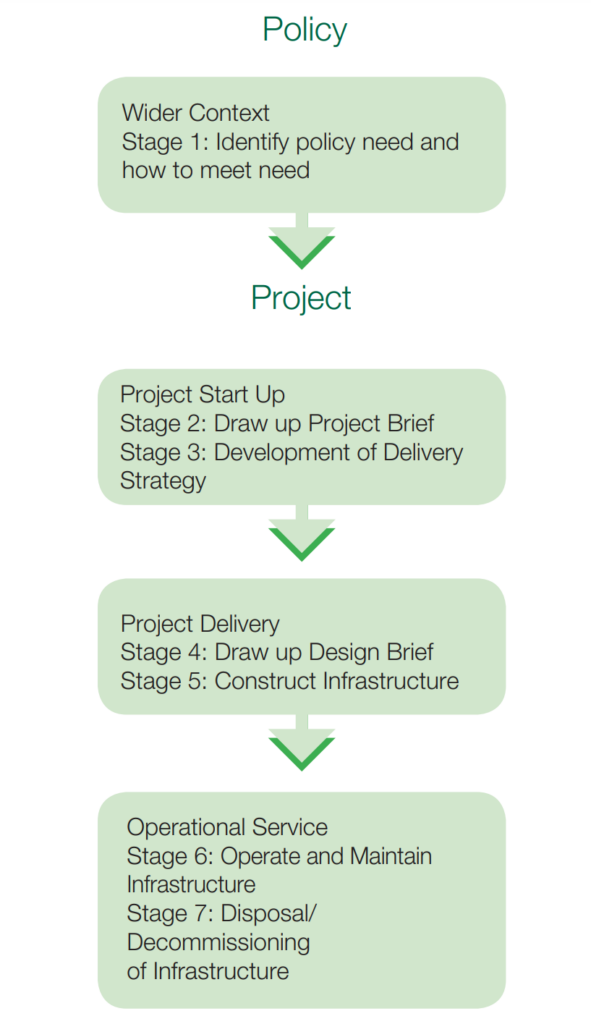MOOC: Auditing environmental impacts of infrastructure
1.2. Stages of Infrastructure Development
The National Audit Office of the United Kingdom (NAO) within the framework of the International Organisation of Supreme Audit Institutions Working Group on Environmental Auditing (INTOSAI WGEA) has compiled a research paper on environmental issues concerning infrastructure development: ‘Environmental Issues Associated with Infrastructure Development’ (INTOSAI WGEA, 2013).
During this research project, the generic seven-stage model for infrastructure development was developed. The model describes the seven key stages in the development and operation of infrastructure, from initial proposals through to the delivery, use and decommissioning of infrastructure.
Infrastructure can be either publicly or privately owned and operated. Likewise, the development of infrastructure objects may be undertaken by the government itself, through public-private partnerships or by the private sector alone. It is important, though, to distinguish the roles of the project developer and the regulator. For example, government entities can be in charge of developing the project, creating the regulation guiding the development and even overseeing the project’s development in accordance with the regulations in place. It is then important an entity is not carrying out opposing roles, e.g. no entity should be the only one carrying out monitoring and supervision activities over its own work.
The model describes the usual stages of project development. It can be adapted to any infrastructure development project. The stages describe the role of the project developer.

Wider Context
Each project starts with the project developer positioning the project in a wider context, i.e. mapping the legislation, requirements and rules that apply in developing the project (Stage 1). In setting out the project options and conducting an appraisal of the options, the likely initial social and environmental impact and estimated project cost should be identified.
Project Start Up
Stage 2, the project brief, requires a fesibility study and/or cost-benefit analysis in order to determine whether the project is achievable, whether it will be profitable and what its environmental and social impact may be.
In Stage 3, the delivery strategy is set. The government can decide to develop the project itself, delegate it to one of its sub-units or involve the private sector. In this stage, it is also important to decide where the funding for the project will come from and wherein lies the ownership of assets and risks, including environmental and social ones. Sustainability strategies, such as involving local communities, sourcing sustainable materials, ect, should be analysed in this stage.
Project Delivery
Stage 4 of the model is the design brief stage, during which the technical solutions and the necessary contracts and procurements are done. Environmental and social requirements may be established to encourage innovative design. When all of this is in place, the infrastructure is built (Stage 5) and the first physical environmental and social impacts are realised. The quality of construction also influences the extent of the future environmental, social and economic outcome.
Operational Service
Once the infrastructure has been built, operation commences (Stage 6). This is (or at least should be) the longest stage of the process. This is also where the biggest environmental and social impact usually occurs. During this stage, it is vital to properly maintain the infrastructure in order to achieve sustainability.
The last stage in the lifecycle of an infrastructure project is the disposal/decommissioning stage (Stage 7). Infrastructure usually last for a relatively long time but is nevertheless not everlasting. In this stage, long-term and substantial environmental damage may also occur. In this stage the environemnt should be preserved and/or restored according to the previously agreed-upon conditions. Projects should ideally include terms and conditions for reinstating the environment to its original state.
Environmental, social and economic impacts are relevant considerations in all of these stages. Infrastructure projects affect land use, ecology, water and material use, air quality and our living environments, property prices, etc. They may also have an impact on public health and safety as well as other social aspects, such as the employment rate. It is necessary for auditors to know what the stages of infrastructure development and operation are and what activities take place during these stages as well as how the development of infrastructure may affect the economy, the environment and the society. In the next module, the legislative framework, requirements and regulations at the disposal of governments for the purpose of governing these stages will be introduced as well as what auditors can focus on at each stage.
 |
Though widely believed and practiced, infrastructure projects don’t have to be audited only when they are completed. Any stage of the of infrastructure development can be audited straight away. For example, Brazil’s Federal Court of Accounts (TCU) prioritises preventive control and directs its efforts so that the work and services rendered by the federal government are carried out within technical standards and at the appropriate cost. Hence, once a year, TCU issues a consolidated report in public works audit (Fiscobras 2020 in Portugese). Fiscobras encompasses a set of TCU control actions in order to verify the process of implementing public works financed totally or partially with federal government resources. |

